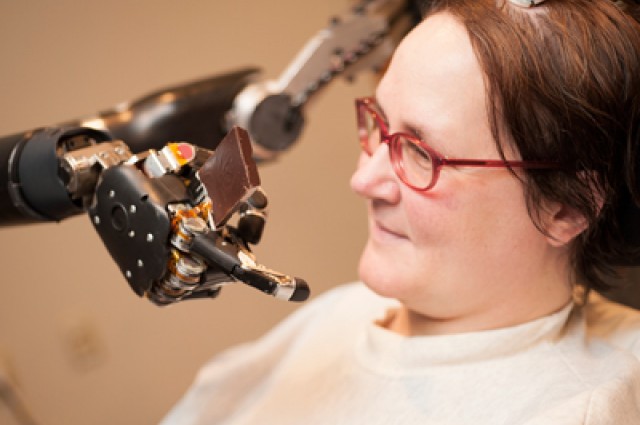
One of the many great things about science is that it is so good at making us say “wow.” Just a few months ago, we shared with you the incredible story of a paralyzed woman who was able to control a robotic arm using only her thoughts, thanks to an innovative brain-machine interface system and a DARPA-led experimental robotics program. Now, the woman has astounded us once again by managing to use her mind to fly an F-35 Joint Strike Fighter in a simulator. This latest breakthrough was shared recently by DARPA (Defense Advanced Research Projects Agency) director Arati Prabhakar at the New America Foundation’s Future of War conference.

Jan Scheuermann, a fifty-five-year-old mother of two, has a neurodegenerative disease that unfortunately rendered her paralyzed from the neck down back in 2003. Almost a decade later, Scheuermann signed herself up for a pioneering trial at the University of Pittsburgh in which surgeons implanted two tiny electrode grids into her brain. They were positioned precisely on a particular spot of the left motor cortex that is responsible for controlling movement of the right arm and hand.
After using computer algorithms to match up patterns of brain activity to thoughts about specific arm movements, Scheuermann was eventually able to control a robotic arm using only her mind. She became remarkably adept at moving the arm and was soon able to move objects around, feed herself a chocolate bar and even give high fives.
Interestingly, Scheuermann was able to control both right-hand and left-hand prosthetic limbs. As the Washington Post points out, this was surprising given that the chips were implanted into her left motor cortex, which is traditionally responsible for controlling movement on the right side of the body.
Since Scheuermann tolerated the implants so well, her participation in the DARPA project was gladly extended. But, according to Prabhakar, she decided that she wanted to try something new and even more challenging. And that new challenge was a simulator of the Pentagon’s newest fighter jet, the F-35 Joint Strike Fighter. Of course, project leaders obliged, and for someone who has never sat in a cockpit before, she did remarkably well.
Prabhakar points out that, rather than thinking about controlling the jet with a joystick, which is what pilots do in training, Jan is thinking about guiding it directly. “For someone who’s never flown—she’s not a pilot in real life—she’s flying that simulator directly from her neural signaling,” Prabhakar said.
At the very least, this groundbreaking system showcases just how far technology and our understanding of the brain and nervous system have come along. But who knows what doors it could open up in the future for those suffering paralysis. Unfortunately, it is nowhere near ready for widespread use, so it will be a while before we see this technology helping others. But if we do reach that stage, Prabhakar points out that there are ethical considerations that should be addressed.
“In doing that work, we’ve also opened this door,” she said. “We can now see the future where we can free the brain from the limitations of the human body. We can all imagine amazing good things and amazing potentially bad things that are on the other side of that door.”
 Previous page
Previous page Back to top
Back to top







